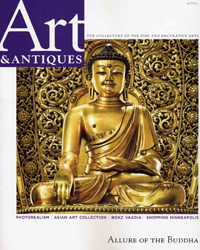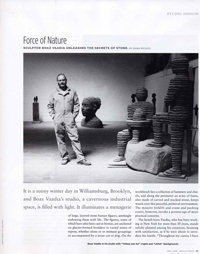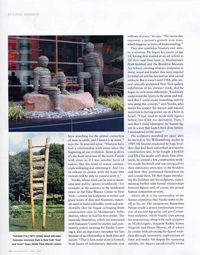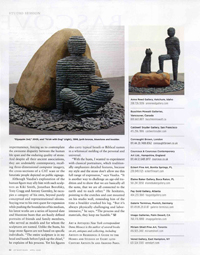



Download article (pdf)
|
Force of Nature
It is a sunny winter day in Williamsburg, Brooklyn, and Boaz Vaadia’s studio, a cavernous industrial space, is filled with light. It illuminates a menagerie of large, layered stone human figures, seemingly endowing them with life. The figures, some of which have also been cast in bronze, are anchored on glacier-formed boulders in varied states of repose, whether alone or in intimate groupings or accompanied by a stone cat or dog. On the workbench lies a collection of hammers and chisels, and along the perimeter an army of busts, also made of carved and stacked stone, keeps watch over this peaceful, primeval environment. The massive forklift and crane and packing crates, however, invoke a present age of more practical concerns.
The Israeli-born Vaadia, who has been working in New York for more than 30 years, stands solidly planted among his creations, beaming with satisfaction, as if he were about to introduce his family. “Throughout my career, I have been searching for the primal connection of man to earth, and I found it in stone,” says the 56-year-old artist. “Humans have had a relationship with stone since the beginning of our evolution. Stone is alive; it’s the bone structure of the earth. I work with stone as if I was another force of nature, like the wind or water, continuously reshaping and reforming it. And I try to release its power with the hope that viewers will be able to connect with it.”
Vaadia, whose work can be seen in museums and public spaces worldwide—for example, in the entrance to the residential tower at the Time Warner Center in New York—creates his sculptures in bolted and glued layers of slate and bluestone, materials used to build sidewalks, roofs and windowsills that he began salvaging from construction sites in Manhattan’s SoHo district, where he had his first studio. The materials themselves, which are associated with humanity’s need for shelter and community, convey meaning for Vaadia. Layering is also an important metaphor for him because of its relationship to both man and nature. “That is how some stone is formed, from layers of sedimentary deposits over millions of years,” he says. “The layers also represent a person’s growth over time, which happens in layers of understanding.”
They also symbolize Vaadia’s own artistic evolution. He began his career at age 14, having first studied at an art school in Tel Aviv and then later at Manhattan’s Pratt Institute and the Brooklyn Museum Art School, creating abstract sculptures in stone, wood and leather that were inspired by tribal art and his fascination with sacred artifacts. But it wasn’t until 1984, after several critically acclaimed New York gallery exhibitions of his abstract work, that he began to view stone differently. “I suddenly understood the layers in the stone and realized that I could create something entirely new using this concept,” says Vaadia, who traces his respect for nature and natural materials to having grown up on a farm in Israel. “I had tried to work with figures before, but it felt too derivative. Then, I saw that I could reinterpret the human figure in a way that hadn’t been done before. I surrendered to the stone.”
His sculptures morphed yet again after he moved to his Williamsburg studio in 1989. He became enamored by huge boulders that had been unearthed at a nearby construction site, so he bought a forklift and filled his studio with them. One afternoon, he invited a few construction workers inside for lunch and was intrigued by their instinctive attraction to the boulders and how they positioned themselves on and around them. He then began introducing the boulders into his sculptures, experimenting further with formal relationships between figures and, of course, the primal human connection to stone.
Above all, it is the universality of the human experience that Vaadia seeks to distill in his art. His anonymous, featureless beings exude a serene timelessness evocative of ancient Egyptian and pre-Columbian sculpture, which Vaadia cites among his inspirations, along with such sculptors as Michelangelo, Auguste Rodin, Isamu Noguchi and Henry Moore, all of whom he credits with advancing the figural tradition through innovative explorations of form and media. Yet despite the reassuring solidity, his figures paradoxically evoke impermanence, forcing us to contemplate the awesome disparity between the human life span and the enduring quality of stone. And despite all their ancient associations, they are undeniably contemporary, recalling three-dimensional computer imagery, the cross-sections of a CAT scan or the futuristic people depicted on public signage.
Although Vaadia’s exploration of the human figure may ally him with such sculptors as Kiki Smith, Jonathan Borofsky, Tony Cragg and Antony Gormley, he occupies a category of his own, beyond purely conceptual and representational idioms. Staying true to his own quest for expansion while pushing the boundaries of his medium, his latest works are a series of layered slate and bluestone busts that are hazily defined portraits of friends and family members, who served as models and for whom the sculptures are named. Unlike the busts, his large stone figures are not based on specific individuals. “The entire sculpture is in my head and hands before I pick up the chisel,” he explains of his process. Yet his figures also carry typical Israeli or Biblical names in a whimsical melding of the personal and universal.
“With the busts, I wanted to experiment with classical portraiture, which traditionally emphasizes detailed features, because my style and the stone don’t allow me this full range of expression,” says Vaadia. “It is another way to challenge an age-old tradition and to show that we are basically all the same, that we are all connected to the earth and to each other.” He hesitates, pointing to the crutches and cast mounted on his studio wall, reminding him of the time a boulder crushed his leg. “But it’s always physically challenging and labor-intensive,” he says. “The process and the materials, they keep me humble.”
Art & Antiques New York correspondent Dana Micucci is the author of several books on art, antiques and collecting, including Artists in Residence: A Guide to the Homes and Studios of Eight 19th-Century Artists In and Around Paris.
Arts and Antiques Magazine Website
|